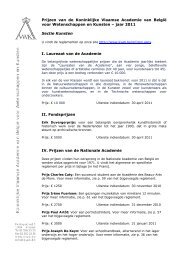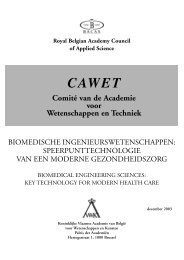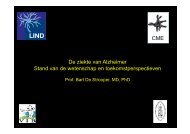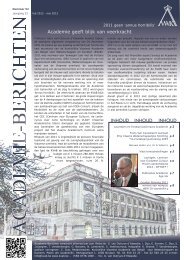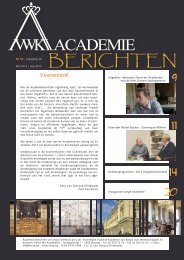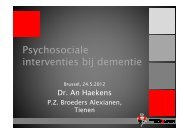High Performance Computing (HPC) in Vlaanderen - Koninklijke ...
High Performance Computing (HPC) in Vlaanderen - Koninklijke ...
High Performance Computing (HPC) in Vlaanderen - Koninklijke ...
You also want an ePaper? Increase the reach of your titles
YUMPU automatically turns print PDFs into web optimized ePapers that Google loves.
Tabel 2.1. The Challenges and Outcomes <strong>in</strong> Science and Eng<strong>in</strong>eer<strong>in</strong>g to beaddressed through Petascale <strong>HPC</strong> Provision.Area Application Science Challenges & Potential OutcomesWEATHER, CLIMATOLOGY AND EARTHSCIENCESASTROPHYSICS, HEP AND PLASMA PHYSICSMATERIALS SCIENCE, CHEMISTRY AND NANOSCIENCEClimate changeOceanography andMar<strong>in</strong>eForecast<strong>in</strong>gMeteorology,Hydrology and AirQualityEarth SciencesAstrophysicsElementaryParticlePhysicsPlasma physicsUnderstand<strong>in</strong>gComplexMaterialsUnderstand<strong>in</strong>gComplexChemistryNanoscienceQuantify uncerta<strong>in</strong>ties on the degree of warm<strong>in</strong>g and the likely impacts by<strong>in</strong>creas<strong>in</strong>g the capability and complexity of ‘whole earth system’ models thatrepresent <strong>in</strong> ever-<strong>in</strong>creas<strong>in</strong>g realism and detail the scenarios for our future climate.Build the most efficient model<strong>in</strong>g and prediction systems to study, understand andpredict ocean properties and variations at all scales, and develop economicallyrelevant applications to <strong>in</strong>form policy and develop services for government and<strong>in</strong>dustry.Predict weather and flood events with high socio-economic and environmentalimpact with<strong>in</strong> a few days. Understand and predict the quality of air at the earth’ssurface; development of advanced real-time forecast<strong>in</strong>g systems for allow<strong>in</strong>g earlyenough warn<strong>in</strong>g and practical mitigation <strong>in</strong> the case of pollution crisis.Sciences Challenges span a wide range of discipl<strong>in</strong>es and have significant scientificand social implications, such as the mitigation of seismic hazards, treatyverification for nuclear weapons, and <strong>in</strong>creased discovery of economicallyrecoverable petroleum resources and monitor<strong>in</strong>g of waste disposal. Increasedcomput<strong>in</strong>g capability will make it <strong>in</strong>creas<strong>in</strong>gly possible to address the issues ofresolution, complexity, duration, confidence and certa<strong>in</strong>ty, and to resolve explicitlyphenomena that were previously parameterized, and will lead to operationalapplications <strong>in</strong> other European centers, national centers and <strong>in</strong> <strong>in</strong>dustry.Deal with systems and structures which span a large range of different length andtime scales; almost always non-l<strong>in</strong>ear coupled systems of ord<strong>in</strong>ary and partialdifferential equations have to be <strong>in</strong>tegrated, <strong>in</strong> 3 spatial dimensions and explicitly<strong>in</strong> time, with rather complex material functions as <strong>in</strong>put. Grand challenges rangefrom the formation of stars and planets to questions concern<strong>in</strong>g the orig<strong>in</strong> and theevolution of the Universe as a whole. Evaluate the huge amount of data expectedfrom future space experiments such as the European Planck Surveyor satellite.Quantum field theories like QCD (quantum chromodynamics) are the topic of<strong>in</strong>tense theoretical and experimental research by a large and truly <strong>in</strong>ternationalcommunity <strong>in</strong>volv<strong>in</strong>g large European centers like CERN and DESY. This researchnot only promise to yield a much deeper understand<strong>in</strong>g of the standard model ofelementary particles and the forces between them, as well as nuclear forces, butis also expected to discover h<strong>in</strong>ts for a yet unknown physics beyond the standardmodel.The science and technology challenge raised by the construction of the magneticconf<strong>in</strong>ement thermonuclear fusion reactor ITER calls for a major theory andmodel<strong>in</strong>g activity. Both the success of the experiment and its safety rely on suchsimulators. The quest to realize thermonuclear fusion by magnetically conf<strong>in</strong><strong>in</strong>g ahigh temperature plasma poses some of the computationally most challeng<strong>in</strong>gproblems of nonl<strong>in</strong>ear physics.The determ<strong>in</strong>ation of electronic and transport properties central to many devices<strong>in</strong> the electronic <strong>in</strong>dustry and hence progress the understand<strong>in</strong>g of technologicallyrelevant materials. Simulations of nucleation, growth, self-assembly andpolymerization central to the design and performance of many diverse materialse.g., rubbers, pa<strong>in</strong>ts, fuels, detergents, functional organic materials, cosmetics andfood. Multiscale descriptions of the mechanical properties of materials to determ<strong>in</strong>ethe relation between process, conditions of use and composition e.g., <strong>in</strong> nuclearenergy production. Such simulations are central to the prediction of the lifetime ofhigh performance materials <strong>in</strong> energy technology, such as high-efficiency gasturb<strong>in</strong>esCatalysis is a major challenge <strong>in</strong> the chemistry of complex materials, with manyapplications <strong>in</strong> <strong>in</strong>dustrial chemistry. The knowledge of atmospheric chemistry iscrucial for environmental prediction and protection (clean air). Improv<strong>in</strong>g theknowledge of chemical process<strong>in</strong>g (from soft chemistry <strong>in</strong>clud<strong>in</strong>g polymers to theatomistic description of combustion) would improve the durability of chemicals.Supra molecular assemblies open new possibilities for the extraction of heavyelements from spent nuclear fuels. In biochemistry, a vast number of reactionstak<strong>in</strong>g place <strong>in</strong> the human body (for example) are not understood <strong>in</strong> any detail. Akey step <strong>in</strong> the development of the clean fuels of the future requires the realistictreatment of supported catalytic nanoparticlesThe advance of faster <strong>in</strong>formation process<strong>in</strong>g or the development of newgenerations of processors requires the shr<strong>in</strong>k<strong>in</strong>g of devices, which leads <strong>in</strong>evitablytowards nanoelectronics. Moreover, many new devices, such as nanomotors can beenvisioned, which will require simulation of mechanical properties at the nanolevel.Composite high performance materials <strong>in</strong> the fields e.g. adhesion and coat<strong>in</strong>gs willrequire an atomistic based description of nanorheology, nanofluidics andnanotribology. As an example the description of the complex magnetic andmechano-optical properties of nanodevices components is only feasible only onsystems <strong>in</strong> the Petaflops range.13




